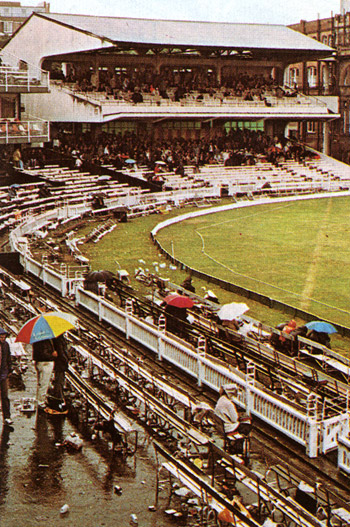The fiery summer
The English summer of 1976 has gone down in folklore as one where water shortages and scorching temperatures left the country parched ... and it had some serious implications for cricket as well
Martin Williamson
22-Jul-2006
|
|

|
Those of us of a certain age have been there before. The summer of 1976 may not have set records - on Wednesday this week, it reached 36.3°C a few miles east of Guildford, where Surrey's annual cricket festival was taking place - but the hot weather was prolonged and there was a marked absence of rain. It also followed on from another very hot year in 1975 and a dry winter in between.
After an ordinary May, the hot stuff began to hit in June, and by the end of the month a number of water companies had applied for drought orders, allowing them to impose bans on using hosepipes. Within a fortnight, what was already being described as the worst drought in 250 years had led to bans. In Suffolk, angry people called the local water board to complain that they were on the verge of being rationed while local cricket pitches were being watered.
On June 28, the sign that things were fast approaching a crisis came when MCC allowed members (men only in those days) to remove their jackets inside the Lord's pavilion for the first time in the club's 189-year history. "They still required ties," noted John Woodcock. "To have included those in the dispensation would have been like letting a man in with only a towel around his waist."
A letter to The Times complained that the result of continuing to maintain cricket squares could lead to a vegetable shortage, as private gardeners had to forgo watering their allotments to allow games to continue. Newspapers blamed the heatwave for an increased death rate, a fall in the value of sterling and a myriad of other gripes. One of these were swarms of ladybirds which coated everything in their path - stumps, spectators and players - and led to a number of delays.
|
|

|
By the time August arrived, things were approaching crisis point. Cricket continued, but groundsmen had long since abandoned watering outfields and were directing all meagre resources to keeping squares from crumbling to dust. In some areas - Kingston-on-Thames was one - the local councils cancelled all sport and abandoned all attempts to maintain the facilities.
No-one really benefited, other than spinners, who thrived on hard and dusty pitches more like those found on the subcontinent. Nine of the top 15 first-class wicket-takers were slow bowlers, and all but one of those (Paddy Clift, who was more military medium) was English.
Batsmen did enjoy outfields which were like motorways, and even half-hearted defensive jabs could run away for four if the ball beat the infield - it just bobbled on its way, and soon fielders realised that chasing was futile. Indeed, it was the fielders who really suffered. Standing in the heat was bad enough, but few then had anything other than studded boots. I can remember taking off my boots after a long session and finding my socks soaked in blood. The studs had been pushed into the sole of the boot by the unforgiving ground and so into my feet.
England captain Tony Greig's habit of wearing a handkerchief tied round his neck under his shirt had been ridiculed - but by August it was all the rage - as were the constant taunts demanding he grovel after his ill-advised comments earlier in the summer. As were sunhats, which had been creeping into use in the previous few years, but which became almost mandatory in 1976. The Times pithily noted that the hairstyles of the players meant that ordinary hats were not practical.
Perhaps the most memorable image of the summer's cricket came at The Oval, whose straw-coloured outfield was being likened to Indore in India as early as the end of June. West Indies, who had thrived in the Caribbean conditions, completed their rout of England in front of what often seemed like a home crowd, Michael Holding taking 14 wickets as the bugles sounded and the beer cans banged.
A few days later - August 27 - the end came when rain stopped play at Lord's for the first time in 10 weeks - it was the first rain of any kind in the capital for more than a month. Alan Gibson said that at the same time at The Oval "the crowd loved it as the players dashed for cover ...'Just like old times' said a woman gleefully, walking past me with a clear plastic hood on her head".
But a rather sobering conclusion. The two hottest summers of the 20th century were 1911 and 1976. The first was followed in 1912 by the wettest and windiest summer on record, the second by one of the coolest. You have been warned.